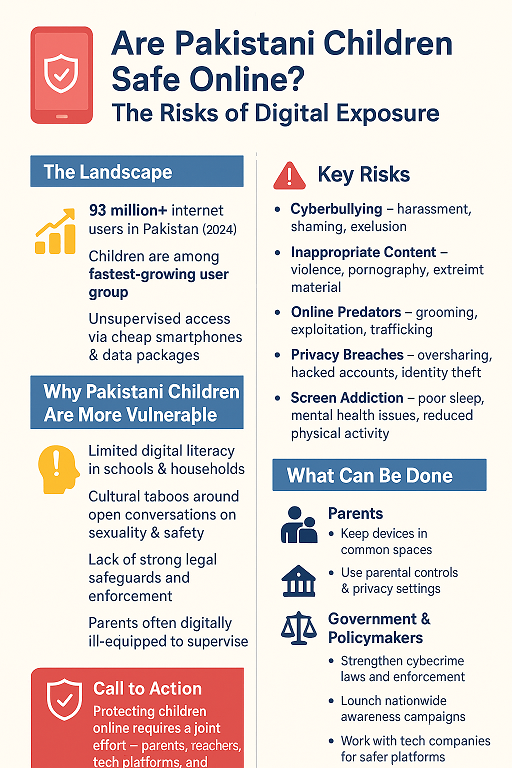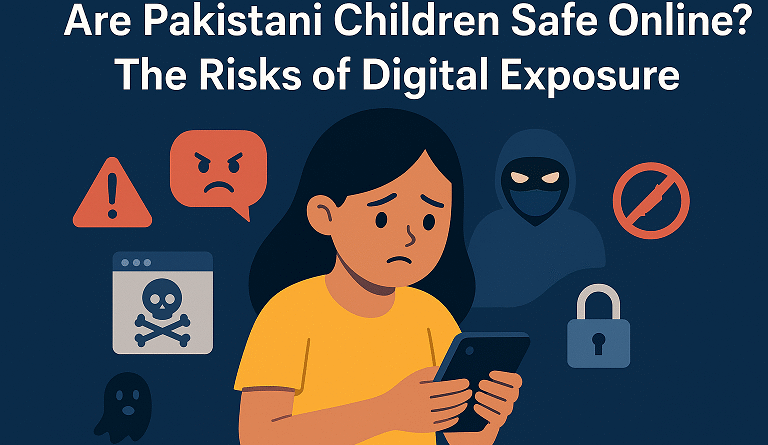Are Pakistani Children Safe Online? The Risks of Digital Exposure
A Growing Digital Footprint, But Rising Dangers
With over 35 million children under 18 in Pakistan accessing the internet, there is always Risk of Safe Online? the digital world presents both promise and peril.
1. Alarming Levels of Online Sexual Abuse
Officials estimate Pakistan ranks third globally in reports of online child sexual abuse material (CSAM), with 5.4 million reports between 2020 and 2022—second only to India and the Philippines.
Surveys by the NGO Sahil show a disturbing human cost: over 12 reported child abuse cases daily, including online-related abuse. Boys accounted for 593, girls for 457 cases among the 6–15 age group in just the first half of 2023.
Reports from Pakistan’s Cyber Harassment Helpline handled 184 child-related complaints in recent years—ranging from intimate image abuse to blackmail.
2. The Invisible Spread: OCSEA & Platform Risks
A broader concern is online child sexual exploitation and abuse (OCSEA). Between 2021 and 2022, over 99% of online reports involved suspected CSAM, indicating Pakistan’s vulnerability to hosting and distributing such content.
However, local law enforcement actions remain limited—only 570 cases reported to the FIA in three years. Of those, just 169 FIRs were registered, with only 6 convictions in 2023.
3. Cyber Threats & Harassment
Violent content, contact from strangers, and financial losses due to scams are common among young users. it always depicts Risk of Safe Online? A Kaspersky survey revealed:
- 54% of kids exposed to violent content
- 18% approached by strangers online
- 25% lost money unwittingly online
- 1 in 5 children chat with strangers daily
Online gaming has become a hotspot for cyber threats. In the first half of 2024, over 130,000 children were targeted via games like Minecraft and Roblox—mostly through malware disguised as cheat downloads.
4. Frameworks & Gaps in Protection
Legal and technical protections exist—but are imperfectly implemented:
- PECA 2016, Pakistan’s core online crimes law, provides penalties for cyber harassment and exploitation—but enforcement falls short.
- The FIA and police often lack the staffing and technical tools to keep pace with digital crimes.
- The Pakistan Telecommunication Authority (PTA) has taken key steps—blocking nearly 1 million pornographic domains, enabling reporting mechanisms, and rolling out digital literacy campaigns in schools in partnership with TikTok and UNICEF.
- In May 2024, the National Cyber Crime Investigation Agency (NCCIA) was created to boost cybercrime investigations.
- PKCERT (National Computer Emergency Response Team) was also set up in 2024 to address broader cybersecurity threats.
5. Awareness & NGO Action
Awareness initiatives are gaining traction.
- PTA, UNICEF, and TikTok launched the “Empowering Every Child Online” campaign in 2025, focusing on skills like identifying harmful behavior and using parental controls.
- The NCRC (National Commission on the Rights of Child) called for informed punishment measures and strengthened reporting systems—including better support for justice officials.
- NGOs like Sahil and the Digital Rights Foundation (DRF) run helplines, conduct training, and offer legal and psychosocial support to child victims.
6. Technical Tools for Parents & Schools
Parents and institutions can deploy tools to mitigate risks:
- Parental control software can filter harmful content, set screen limits, monitor usage, and block unwelcome contacts.
- Awareness workshops, especially in local languages, help parents and children build safe online habits.
Summary Table Risk of Safe Online?
| Area | Risk & Issue | Measures & Protection |
|---|---|---|
| CSAM & OCSEA | High volume of reports, low convictions | PTA reporting, DRF/Sahil support, NCCIA, PKCERT |
| Exposure to Harm | Violent content, stranger contact, financial scams, gaming threats | Parental oversight, digital education, awareness campaigns |
| Implementation Gaps | Limited law enforcement capability and fragmented platform policies | PTA actions, NCCIA creation, stronger multi-stakeholder coordination |

Conclusion Risk of Safe Online?
While digital connectivity offers access and learning, Pakistani children face serious risks online. The data paints a stark picture: high exposure to abuse, gaming-targeted threats, and insufficient legal execution.
Effective protection requires accelerating digital literacy campaigns, strengthening technical law enforcement capacity (like NCCIA and PTA), expanding NGO support, and empowering parents with tools and conversation.
End with this: A safe digital tomorrow for Pakistani children depends on vigilance, collaboration, and technology—with heart.

